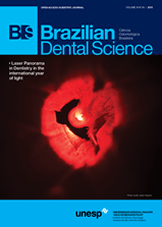Temporomandibular disorder in children at deciduous and mixed denture
DOI:
https://doi.org/10.14295/bds.2015.v18i4.1188Abstract
The temporomandibular joint (TMJ) plays an important role in the function of stomatognathic system. The acronym TMD – Temporomandibular disorder – is a general term for a series of signs and symptoms involving the masticatory muscles, TMJ, and associated structures. TMDs have a multifactorial etiology despite that many controversies still exist on this subject. Structural factors as trauma, malocclusion, systemic hypermobility, oral parafunctions, and emotional conditions (stress, anxiety, and depression) may trigger TMDs appearance. Objective: This study aimed to evaluate the signs and clinical symptoms of TMDs in patients treated at the School of Dentistry of the Institute of Science and Technology of São José dos Campos – UNESP - SP. Material and Methods: Fifty patients, both genders, aged between five and thirteen years were examined through muscle palpation and auscultation. Intra and extraoral examinations were performed, observing occlusion interference, denture type, protrusion or retrusion of the mandible, open bite or crossbite, edge-to-edge bite relation, midline shifts, limitation of mouth opening, and mandible shift during mouth opening and closing. Anamnesis comprised questions on the child’s habits and symptoms noticeable by the parents or legal guardians, information on the child’s personality and mood. Results: The obtained data were analyzed through percentage and qualitative analysis. Conclusion: It can be concluded that children exhibited signs and symptoms of TMDs, but TMDs presence cannot be affirmed in the studied sample; stress or altered behavior influenced on the presence of the signs and symptoms in the TMJ area
Keywords
Temporomandibular joint; Mixed dentition; Primary dentition; Temporomandibular joint dysfunction syndrome.
Downloads
Downloads
Published
How to Cite
Issue
Section
License
Brazilian Dental Science uses the Creative Commons (CC-BY 4.0) license, thus preserving the integrity of articles in an open access environment. The journal allows the author to retain publishing rights without restrictions.
=================






























